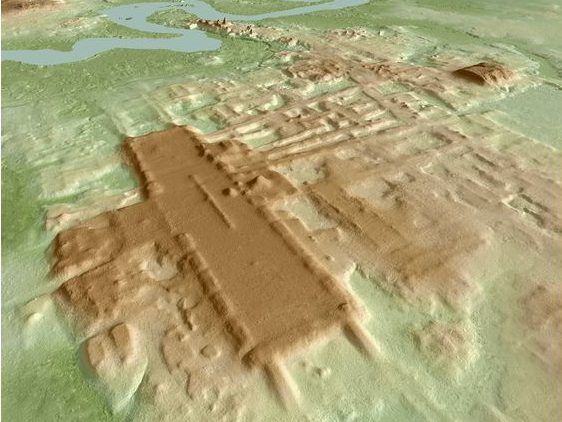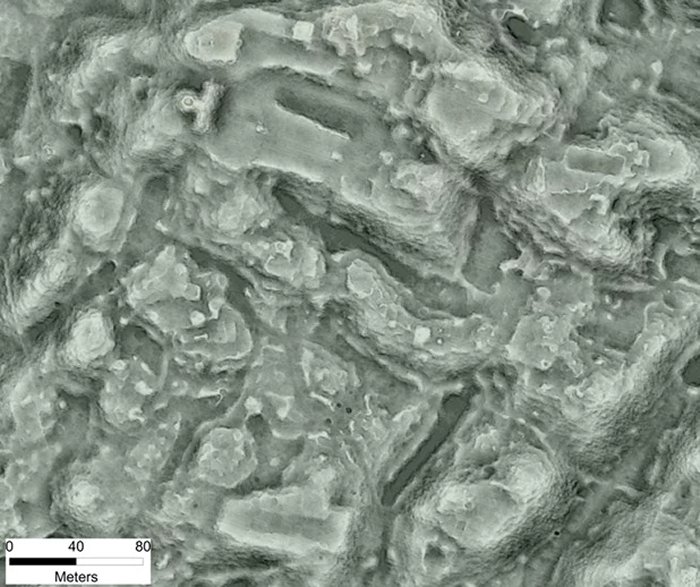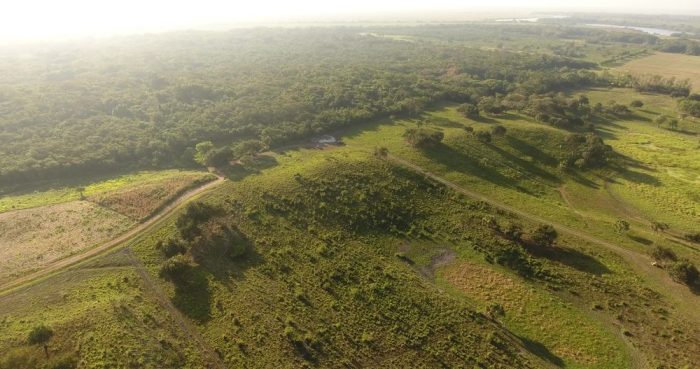Anthropology
Related: About this forumLost Monument of Early Maya Civilisation Discovered in Mexico

By George Dvorsky on 03 Jun 2020 at 11:30AM
The surprising discovery of a 2,800-year-old monumental structure in Tabasco, Mexico, is shaking our conceptions of Maya civilisation and its emergence as a cultural force.
Using a technology called lidar, in which lasers are used to map hidden surface features from above, archaeologists discovered a previously unknown monumental structure at the Aguada Fénix site in Mexico. This artificial platform – presumably used for naked-eye astronomy – is now the earliest and largest ceremonial structure belonging to the Maya civilisation. Details of this remarkable discovery were published today in Nature.
The platform and its supporting structures, including reservoirs, causeways, and a pyramid-like mound, were found in the Maya lowlands and radiocarbon dated to between 3,000 and 2,800 years ago. It’s conventionally believed that the development of Maya civilisation was a slow and gradual process, with small villages emerging between 2,000 and 1,650 years ago. That such a large and sophisticated ceremonial complex appeared so long ago comes as a big surprise, and its early presence is challenging traditional notions of when Maya civilisation began to emerge.
Indeed, there’s much to learn about the Maya, as much of their legacy remains hidden beneath a huge blanket of trees. Two years ago, for example, a comprehensive aerial survey uncovered 61,480 distinct ancient Maya structures in the lush rainforests of Guatemala. Lidar has led to similar discoveries at Angkor Wat in Cambodia, in which the jungle-penetrating laser uncovered a hidden early capital of the Khmer Empire.
More:
https://www.gizmodo.co.uk/2020/06/lost-monument-of-early-maya-civilisation-discovered-in-mexico/
Judi Lynn
(163,734 posts)
https://www.eluniversal.com.mx/english/major-discovery-oldest-and-largest-maya-structure-mexico-sheds-light-rise-ancient
(I hope this appears in English on your computer, mine translates Spanish to English, usually.)
Judi Lynn
(163,734 posts)Author of the article:Reuters
Publishing date:12 hours ago • 1 minute read

A three-dimensional image of the ancient Maya Aguada Fenix site in Mexico's Tabasco state based on lidar, an aerial remote-sensing method, is seen in this picture released on June 3, 2020. TAKESHI INOMATA / VIA REUTERS
WASHINGTON — Scientists using an aerial remote-sensing method have discovered the largest and oldest-known structure built by the ancient Maya civilization – a colossal rectangular elevated platform built between 1,000 and 800 BC in Mexico’s Tabasco state.
The structure, unlike the soaring Maya pyramids at cities like Tikal in Guatemala and Palenque in Mexico erected some 1,500 years later, was not built of stone but rather of clay and earth, and likely was used for mass rituals, researchers said on Wednesday.
Located at a site called Aguada Fenix near the Guatemalan border, the structure measured nearly a quarter mile (400 meters) wide and nine-tenths of a mile (1,400 meters) long and stood 33 to 50 feet (10 to 15 meters) high. In total volume, it exceeded ancient Egypt’s Great Pyramid of Giza built 1,500 years earlier.
There were no signs of sculptures depicting high-status individuals, suggesting Maya culture at this early stage was more communal and only later developed social inequality and a hierarchical society led by royalty, the researchers said.
More:
https://windsorstar.com/technology/oldest-and-largest-ancient-maya-structure-found-in-mexico/wcm/1ad07247-c33b-4634-9610-6f891bfa8680/
Judi Lynn
(163,734 posts)Site at Aguada Fénix found using lidar aerial laser technology
Vast earth platform exceeds volume of Great Pyramid of Giza
Reuters in Washington
Wed 3 Jun 2020 12.04 EDT

Unlike later structures such as Dzibilchaltun, in Yucatán state, the newly discovered structure at Aguada Fénix, Mexico, was not built of stone, but rather of clay and earth. Photograph: Hugo Borges/AFP/Getty Images
Scientists using an aerial remote-sensing method have discovered the largest and oldest-known structure built by the ancient Maya civilization – a colossal rectangular elevated platform built between 1000 and 800BC in Mexico’s Tabasco state.
The structure, unlike the soaring Maya pyramids at cities like Tikal in Guatemala and Palenque in Mexico erected some 1,500 years later, was not built of stone but rather of clay and earth, and was probably used for mass rituals, researchers said on Wednesday.
Located at a site called Aguada Fénix near the Guatemalan border, the structure measured nearly a quarter-mile (400 meters) wide and nine-tenths of a mile (1,400 meters) long and stood 33 to 50 ft (10 to 15 meters) high. In total volume, it exceeded ancient Egypt’s Great Pyramid of Giza built 1,500 years earlier.
There were no signs of sculptures depicting high-status individuals, suggesting Maya culture at this early stage was more communal and only later developed social inequality and a hierarchical society led by royalty, the researchers said.
More:
https://www.theguardian.com/science/2020/jun/03/maya-structure-discovered-mexico-lidar-aguada-fenix
~ ~ ~
Older article from different location:
This article is more than 2 years old
Laser scanning reveals 'lost' ancient Mexican city 'had as many buildings as Manhattan'
This article is more than 2 years old
Groundbreaking lidar scanning reveals the true scale of Angamuco, built by the Purépecha from about 900AD
Nicola Davis in Austin
@NicolaKSDavis
Thu 15 Feb 2018 11.00 EST

One of Angamuco’s ‘neighbourhoods’, revealed using light detection and ranging scanning. Photograph: C Fisher
Archaeology might evoke thoughts of intrepid explorers and painstaking digging, but in fact researchers say it is a high-tech laser mapping technique that is rewriting the textbooks at an unprecedented rate.
The approach, known as light detection and ranging scanning (lidar) involves directing a rapid succession of laser pulses at the ground from an aircraft.
The time and wavelength of the pulses reflected by the surface are combined with GPS and other data to produce a precise, three-dimensional map of the landscape. Crucially, the technique probes beneath foliage – useful for areas where vegetation is dense.
Earlier this month researchers revealed it had been used to discover an ancient Mayan city within the dense jungles of Guatemala, while it has also helped archaeologists to map the city of Caracol – another Mayan metropolis.
Now, researchers have used the technique to reveal the full extent of an ancient city in western Mexico, about a half an hour’s drive from Morelia, built by rivals to the Aztecs.
“To think that this massive city existed in the heartland of Mexico for all this time and nobody knew it was there is kind of amazing,” said Chris Fisher, an archaeologist at Colorado State University who is presenting the latest findings from the study at the conference of the American Association for the Advancement of Science in Austin, Texas, this week.
While less well known than the Aztecs, the Purépecha were a major civilisation in central Mexico in the early 16th century, before Europeans arrived and wreaked havoc through war and disease. Purépecha cities included an imperial capital called Tzintzuntzan that lies on the edge of Lake Pátzcuaro in western Mexico, an area in which modern Purépecha communities still live.
More:
https://www.theguardian.com/science/2018/feb/15/laser-scanning-reveals-lost-ancient-mexican-city-had-as-many-buildings-as-manhattan
Judi Lynn
(163,734 posts)By Yucatan Times on June 3, 2020

An aerial view of the area southwest of Aguada Fenix (Tabasco, Mexico). TAKESHI INOMATA
Researchers relate the construction to the transition from an itinerant lifestyle to a more sedentary one.
TABASCO Mexico (El País) – A walk through Aguada Fenix in Tabasco Mexico is like walking on sandy roads surrounded by a dense natural landscape. “No one suspected what lay beneath,” says Takeshi Inomata, a researcher at the School of Anthropology at the University of Arizona in the United States and author of a study published Wednesday in Nature.
According to the study’s descriptions, the dirt roads and numerous trees hide an artificial Mayan platform that extends over an astonishing area of some 563,000 square meters. It is the largest and most ancient structure discovered so far in the Mayan civilization, marking the transition from an itinerant to a more sedentary lifestyle since 950 BC.
Thanks to the Lídar technology, a laser detection method that creates a three-dimensional map, a set of ceremonial centers were drawn, built between 1000 and 800 B.C., about 10 to 15 meters high and from which nine roadways emerge. “It was impressive to see all that surface area. It’s huge,” the researcher confirms.

Melina Garcia, one of the researchers, in Aguada Fenix looking for evidence. TAKESHI INOMATA
The discovery challenges the models conceived so far. To begin with, the scientific community thought that the Mayan civilization was built little by little, that is, village by village, until it reached more massive structures. But this excavation shows the opposite: they started from the largest to create the small. “I think that having such a strong base helped them to organize themselves and spread out into smaller villages,” says Inomata.
More, with photos:
https://www.theyucatantimes.com/2020/06/the-oldest-and-largest-mayan-monumental-structure-known-to-date-discovered/
Judi Lynn
(163,734 posts)New find raises questions regarding size and timing of large settlements in Central America.

3D image of the recently recognized Maya site of Aguada Fenix, based on lidar.
Image credits:
Takeshi Inomata
Rights information:
May be used with this Inside Science story, with credit given.
Wednesday, June 3, 2020 - 11:00
Charles Q. Choi, Contributor
(Inside Science) -- A giant platform nearly a mile long made of stone, clay and earth is both the earliest and largest known monumental structure constructed by the ancient Maya, dwarfing their biggest pyramids in magnitude, a new study finds.
The people known as the ancient Maya lived in an area the size of Texas across what is now southern Mexico and northern Central America, including the modern countries of Guatemala, Belize, El Salvador and Honduras. At its height, known as its Classic period, which spanned from roughly A.D. 250 to 900, the Maya arguably had the most advanced civilization in the Americas, raising cities known for their stone pyramids.
Archaeologists long thought the Maya gradually shifted from a mobile way of life to permanent settlements during the Preclassic period that spanned from roughly 1800 B.C. to A.D. 250, emerging with villages during the Middle Preclassic from 1000 to 400 B.C. However, the discovery of major cities built during the Preclassic challenge this model. For example, the La Danta pyramid complex in the Preclassic city El Mirador rises 72 meters high with a base 500 meters by 300 meters large, dwarfing any Maya pyramids of later periods.
Now scientists have discovered the largest known ancient Maya ceremonial structure, a platform roughly 1.4 kilometers long, 400 meters wide and 10 to 15 meters high. Radiocarbon dating of charcoal samples from the platform revealed it was constructed between 1000 and 800 B.C., which also makes it the oldest known ancient Maya ceremonial structure.
The site lies partly on Rancho Fénix (Phoenix Ranch) in Tabasco, Mexico. Since artificial reservoirs, called aguadas, are prominent features of the area, the researchers named the site Aguada Fénix.
More:
https://www.insidescience.org/news/largest-known-maya-structure-found-more-4000-feet-long-and-nearly-3000-years-old?fbclid=IwAR3r4xyeDZyXYQiUitDL42gLcRkK8ORPKJc5FI3Yt9HDBtYcfdyL-8IMmO8